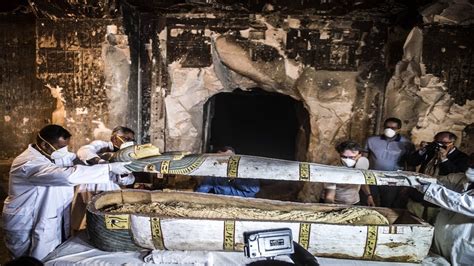
Archaeologists in Egypt have unearthed three tombs dating back approximately 3,500 years to the New Kingdom era, potentially holding significant clues about the lives of high-ranking officials from that period. The discovery, announced by the Egyptian Ministry of Tourism and Antiquities, took place in the ancient necropolis of Saqqara, south of Cairo, revealing painted wooden coffins, human remains, and various artifacts.
The Supreme Council of Antiquities’ mission discovered the tombs, which date back to the 18th and 19th dynasties. According to the ministry, one tomb belonged to a royal scribe named Khonsu, who headed the altar of King Amenhotep III, while another belonged to a person named Yaa, and the third belonged to a man named Meryaman, a high-ranking official.
“These tombs were part of the cemetery of high officials of the New Kingdom,” the ministry stated. Further excavations are planned to uncover more about the history and details surrounding these individuals and the era in which they lived.
Unearthing the Past: Details of the Saqqara Tombs
The Saqqara necropolis, a vast burial ground serving the ancient Egyptian capital of Memphis, has consistently yielded significant archaeological discoveries over the years. The newly discovered tombs add to this rich tapestry of history, providing valuable insights into the social, religious, and political landscape of the New Kingdom (c. 1550-1070 BC).
The tomb of Khonsu, the royal scribe, is of particular interest due to his close association with King Amenhotep III, a powerful ruler of the 18th Dynasty. Amenhotep III’s reign was marked by prosperity, artistic achievement, and extensive building projects, including the construction of magnificent temples and monuments. Khonsu’s role as the head of the altar suggests he held a position of considerable influence within the royal court, overseeing religious rituals and ceremonies. The artifacts found within his tomb are expected to shed light on the religious practices and beliefs of the time, as well as Khonsu’s personal life and career.
The second tomb, belonging to a person named Yaa, offers another glimpse into the lives of individuals who lived during this period. While the exact nature of Yaa’s role in society is not yet known, the contents of his tomb will likely provide clues about his social status, occupation, and personal beliefs. The discovery of human remains within the tomb will also allow researchers to conduct anthropological studies, gaining insights into the health, diet, and genetic makeup of the ancient Egyptians.
The third tomb, belonging to Meryaman, who held a high-ranking position, further enriches the understanding of the administrative and social hierarchy of the time. The title held by Meryaman indicates a position of authority and responsibility, suggesting he played a significant role in the management of state affairs or the oversight of important projects. The artifacts found within his tomb may include administrative documents, personal belongings, and religious objects, providing valuable information about his daily life and responsibilities.
The discovery of painted wooden coffins within the tombs is particularly significant. Wooden coffins were commonly used for burials during the New Kingdom, and they often were adorned with intricate decorations and inscriptions. These decorations provide valuable information about the deceased, including their name, titles, and religious beliefs. The inscriptions often include prayers and spells intended to ensure the safe passage of the deceased into the afterlife. The analysis of the painted wooden coffins will undoubtedly reveal further details about the artistic styles and religious beliefs of the time.
The Significance of Saqqara
Saqqara served as the necropolis for Memphis, the ancient capital of Egypt, for over 3,500 years. It’s home to numerous pyramids, including the Step Pyramid of Djoser, the oldest complete stone building complex in Egypt, built during the Third Dynasty (c. 2686-2613 BC). The area was not only a burial ground for royalty but also for high officials, priests, and other prominent individuals, making it a vast repository of Egyptian history and culture.
The Saqqara necropolis is more than just a collection of tombs and pyramids; it is a living testament to the ingenuity, creativity, and spiritual beliefs of the ancient Egyptians. The site has been the focus of intense archaeological activity for centuries, and each new discovery adds to our understanding of this fascinating civilization.
The importance of Saqqara stems from several factors. First, its long history as a burial ground means that it contains a vast amount of archaeological material, spanning several millennia. Second, the variety of tombs and monuments found at Saqqara reflects the diverse social and economic strata of ancient Egyptian society. Finally, the well-preserved state of many of the tombs and artifacts at Saqqara provides a unique opportunity to study the art, architecture, and religious beliefs of the ancient Egyptians.
The New Kingdom: A Golden Age of Egypt
The New Kingdom, during which these tombs were constructed, represents a golden age in Egyptian history. Following a period of foreign rule by the Hyksos, the New Kingdom pharaohs re-established Egyptian control over the country and expanded its influence throughout the Near East. This era saw a flourishing of art, architecture, and literature, as well as significant advances in science and technology.
The New Kingdom was a period of great prosperity and expansion for Egypt. The pharaohs of this era led military campaigns to conquer new territories and establish trade routes, bringing wealth and resources back to Egypt. This wealth was used to fund ambitious building projects, including the construction of magnificent temples, palaces, and tombs.
The New Kingdom was also a time of great religious innovation. The pharaoh Akhenaten introduced a new monotheistic religion centered on the worship of the sun god Aten. Although Akhenaten’s religious reforms were short-lived, they had a profound impact on Egyptian society and culture.
The Importance of the Discovery
The unearthing of these tombs contributes significantly to our understanding of ancient Egyptian society, religious practices, and burial customs during the New Kingdom. The artifacts and human remains discovered within the tombs offer invaluable insights into the lives of the individuals buried there, as well as the broader historical context of the era.
The discovery is significant for several reasons. First, it provides new information about the lives and careers of high-ranking officials during the New Kingdom. Second, it sheds light on the religious beliefs and burial practices of the ancient Egyptians. Third, it highlights the importance of Saqqara as a major archaeological site.
The careful excavation and study of these tombs will undoubtedly yield further discoveries in the years to come, helping to piece together a more complete picture of ancient Egyptian history. The ongoing research at Saqqara promises to reveal even more secrets about this fascinating civilization, ensuring that its legacy continues to inspire and captivate us for generations to come. The information gleaned from these sites will be essential for understanding the administration, religious beliefs, and daily lives of the elite during a pivotal period in Egyptian history. The details of the artifacts found within could also provide insights into the trade networks and artistic influences of the time.
Future Excavations and Research
The Egyptian Ministry of Tourism and Antiquities has announced plans for further excavations at the Saqqara site. These excavations are expected to uncover more tombs and artifacts, providing even greater insights into the history of ancient Egypt. The research will involve a multidisciplinary approach, bringing together archaeologists, anthropologists, historians, and other specialists.
The excavation process itself is a meticulous and time-consuming undertaking. Archaeologists carefully remove layers of soil and debris, documenting each find with photographs and detailed notes. Artifacts are carefully cleaned, conserved, and analyzed in order to determine their age, origin, and purpose.
The research team will also be conducting anthropological studies of the human remains found in the tombs. These studies will provide information about the health, diet, and genetic makeup of the ancient Egyptians. By analyzing the bones and teeth of the deceased, researchers can learn about the diseases that afflicted them, the foods they ate, and their overall physical condition.
The ongoing research at Saqqara is a testament to the enduring fascination with ancient Egypt. The discoveries made at this site continue to captivate the public and inspire new generations of archaeologists and historians. As the excavations continue, we can expect to uncover even more secrets about this remarkable civilization.
Preservation and Tourism
The Egyptian government is committed to preserving its ancient heritage for future generations. The Ministry of Tourism and Antiquities is working to protect the Saqqara site from damage and vandalism. Efforts are also being made to promote tourism to the area, allowing visitors to experience the wonders of ancient Egypt firsthand.
The preservation of archaeological sites is a complex and challenging undertaking. The sites are often exposed to the elements, which can cause erosion and deterioration. Vandalism and looting are also a threat. In order to protect these sites, the Egyptian government has implemented a number of measures, including the construction of protective barriers, the installation of security cameras, and the training of local communities to act as custodians of the sites.
Tourism is an important source of revenue for Egypt, and the government is working to promote tourism to the Saqqara site. Visitors to Saqqara can explore the Step Pyramid of Djoser, as well as numerous other tombs and monuments. The site also features a museum, which displays a collection of artifacts discovered at Saqqara.
The combination of archaeological research, preservation efforts, and tourism promotion ensures that the legacy of ancient Egypt will continue to inspire and captivate us for generations to come. The careful management of the Saqqara site is essential for preserving its cultural heritage and ensuring that it remains a valuable resource for education and tourism.
Quotes from Officials
“These discoveries are important because they give us more insight into the history of the New Kingdom and the lives of the people who lived during that time,” said a representative from the Ministry of Tourism and Antiquities. “We hope that these discoveries will encourage more people to visit Egypt and learn about our ancient history.”
FAQ Section:
1. Where were these tombs discovered?
The tombs were discovered in the Saqqara necropolis, located south of Cairo, Egypt. Saqqara served as the burial ground for the ancient Egyptian capital of Memphis.
2. How old are these tombs?
The tombs are approximately 3,500 years old, dating back to the New Kingdom era (c. 1550-1070 BC) of ancient Egypt.
3. Who did the tombs belong to?
According to the Ministry, one tomb belonged to Khonsu, a royal scribe and head of the altar of King Amenhotep III. Another belonged to Yaa, and the third belonged to Meryaman, who held a high-ranking position.
4. What was found inside the tombs?
Archaeologists found painted wooden coffins, human remains, and various artifacts inside the tombs. Further analysis is needed to determine the specific nature and significance of these findings.
5. Why is this discovery important?
This discovery is important because it provides valuable insights into the lives of high-ranking officials and the social, religious, and political landscape of the New Kingdom era in ancient Egypt. The artifacts and human remains found within the tombs can reveal details about burial customs, religious beliefs, and daily life during this period.
Expanded Context and Analysis:
The discovery of these three tombs in Saqqara contributes to the ongoing effort to reconstruct the history of ancient Egypt, particularly the New Kingdom period. This era, characterized by its powerful pharaohs and expansive empire, left behind a wealth of archaeological evidence that continues to captivate researchers and the public alike.
The location of the tombs within the Saqqara necropolis is particularly significant. As the primary burial ground for the ancient capital of Memphis, Saqqara holds a vast repository of information about Egyptian civilization spanning millennia. The site is home to numerous pyramids, including the iconic Step Pyramid of Djoser, as well as countless tombs of pharaohs, nobles, priests, and other prominent individuals. The sheer scale and diversity of Saqqara make it an unparalleled resource for understanding the evolution of Egyptian society, religion, and culture.
The discovery of the tombs belonging to Khonsu, Yaa, and Meryaman offers a glimpse into the lives of individuals who played important roles in the administration and religious life of the New Kingdom. Khonsu’s position as a royal scribe and head of the altar of King Amenhotep III suggests that he was a highly educated and influential figure within the royal court. His responsibilities likely included managing royal records, drafting official documents, and overseeing religious ceremonies. The artifacts found within his tomb may include writing implements, papyrus scrolls, and religious objects, providing valuable insights into his daily life and professional activities.
The identity of Yaa remains more enigmatic, but the contents of his tomb are likely to shed light on his social status and occupation. The discovery of personal belongings, tools, or other artifacts could provide clues about his role in society and his economic activities. Anthropological analysis of his remains may also reveal information about his health, diet, and lifestyle.
Meryaman’s high-ranking position suggests that he held a position of authority and responsibility within the Egyptian government or religious hierarchy. The artifacts found within his tomb may include administrative documents, seals of office, and religious symbols, providing insights into his duties and responsibilities. The discovery of his tomb may also contribute to our understanding of the structure and organization of the Egyptian bureaucracy during the New Kingdom.
The painted wooden coffins found within the tombs are particularly important sources of information. These coffins were typically decorated with elaborate scenes and inscriptions that reflect the religious beliefs and funerary practices of the ancient Egyptians. The paintings often depict scenes from the afterlife, as well as images of gods and goddesses. The inscriptions often include prayers and spells designed to ensure the safe passage of the deceased into the next world. The study of these coffins can provide valuable insights into the religious beliefs and artistic styles of the New Kingdom.
The analysis of the human remains found within the tombs is also an important aspect of the archaeological investigation. Anthropologists can study the bones and teeth of the deceased to learn about their age, sex, health, and diet. They can also examine the remains for evidence of disease, injury, or trauma. This information can help to reconstruct the lives of the individuals buried in the tombs and to understand the health and living conditions of the ancient Egyptian population.
The Egyptian Ministry of Tourism and Antiquities’ commitment to preserving the Saqqara site and promoting tourism to the area is essential for ensuring that this invaluable cultural heritage is protected for future generations. The ongoing archaeological research at Saqqara is a testament to the enduring fascination with ancient Egypt and the importance of preserving its rich history. The discoveries made at Saqqara continue to captivate the public and inspire new generations of archaeologists and historians. As the excavations continue, we can expect to uncover even more secrets about this remarkable civilization, adding to our understanding of its achievements and its legacy.
The process of excavation and analysis is a complex and time-consuming undertaking, requiring the expertise of a multidisciplinary team of specialists. Archaeologists carefully remove layers of soil and debris, documenting each find with photographs, drawings, and detailed notes. Artifacts are carefully cleaned, conserved, and analyzed in order to determine their age, origin, and purpose. The research team also includes anthropologists, who study the human remains found in the tombs, and historians, who analyze the historical context of the discoveries.
The discoveries in Saqqara also highlight the importance of international collaboration in archaeological research. The Egyptian government has welcomed researchers from around the world to participate in the excavations at Saqqara, fostering a spirit of cooperation and shared knowledge. This collaborative approach has led to significant advances in our understanding of ancient Egypt and has helped to ensure that the site is properly preserved and protected.
The ongoing research at Saqqara is not only important for understanding the history of ancient Egypt, but also for understanding the broader history of humanity. The discoveries made at Saqqara provide insights into the development of civilization, the evolution of religious beliefs, and the diversity of human cultures. By studying the past, we can gain a better understanding of the present and the future.
The Egyptian government’s commitment to preserving its ancient heritage is also important for promoting tourism and economic development. Tourism is a major source of revenue for Egypt, and the country’s ancient sites are a major draw for visitors from around the world. By investing in the preservation and promotion of its ancient heritage, Egypt can attract more tourists and create jobs for its citizens.
The discovery of the three tombs in Saqqara is a reminder of the rich and complex history of ancient Egypt. The ongoing research at Saqqara promises to reveal even more secrets about this remarkable civilization, ensuring that its legacy continues to inspire and captivate us for generations to come.









